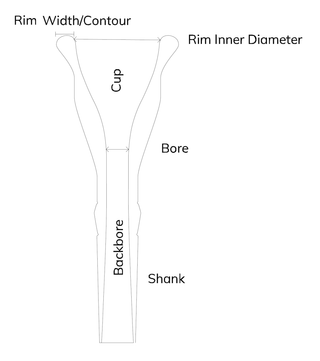
Have you ever heard people throwing around words like ‘backbore’ and ‘rim contour’ and wondered what they mean? Here’s your guide to the anatomy of a horn mouthpiece.
Material of the Cup
(Listed in order from softest to hardest.)
The harder the metal, the quicker the response, but the sound will be less complex.
- Brass
- Aluminum Bronze
- Stainless Steel
Cup Shape
- More bowl-shaped = More sonorous sound, with a decrease in flexibility
- More V-shaped = More flexibility, simpler sound
- More volume (depth) = Heavier, but more covered sound
- Less volume (depth) = Lighter, more open sound
Material of the Rim
(Listed in order from stickiest to slickest.)
- Silver-Plated Brass
- Stainless Steel
- Gold-Plated Brass
- Titanium-Plated Stainless Steel (H-Kote)
Inner Rim Diameter
This is not universally true, but wider inner rim diameters usually work better for larger, thicker lips.
16.5 mm – 19 mm
Rim Contour
The rim width is the surface area of the rim that firmly makes contact with the embouchure.
- Wider rim = More endurance, less flexibility, drier sound.
- More rounded rim = Less surface area making contact with the embouchure.
- More bite (sharper rim) = More pointed, but potentially harsher articulation.
Bore
The larger the bore, the bigger and less focused the sound.
Backbore
Shank Taper
- Morse (Standard) Taper – Used for almost all horns, including most horns made abroad and imported to North America.
- European Taper – Used for Alexander horns and horns made in Europe for the European, Asian, and South American markets.
- There are exceptions to the above two generalizations.
Is there anything we left out? Leave your questions in the comment section below!
Don’t know which mouthpiece is right for you? Schedule a mouthpiece trial with a professional musician.

